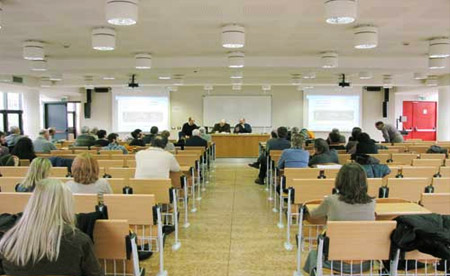Course not running
- Course code
- 4S003214
-
Name of lecturer
-
Elvira Migliario
- Coordinator
-
Elvira Migliario
- Number of ECTS credits allocated
-
6
-
Other available courses
-
- Academic sector
-
L-ANT/03 - ROMAN HISTORY
- Language of instruction
- Italian
- Location
- VERONA
- Period
-
I semestre - sede Trento dal Sep 18, 2017 al Dec 22, 2017.
Lesson timetable
Go to lesson schedule
Learning outcomes
The course consists of two different sections (A, B), 6 CFU each (30 hours = 15 lectures each one); section B is addressed to students needing to gain 12 CFU of Roman history LM.
Section A, i.e. an "Introduction to Roman epigraphy", aims to introduce to the subject of inscriptions and provide some guidance towards reading and understanding the epigraphic texts (mostly in Latin).
Students will be led to: acquire some basic technical skills of the epigraphic technique, firstly in reading and dating the inscriptions; know the historical development of the epigraphic science, as well as its main collections and editions. At the end of the course, students are expected to be able to read, translate, understand, and comment the given inscriptions, grasping their helpfulness and value as fundamental sources for any thorough study about ancient Roman world.
Section B, i.e. “Rome and the near East: from the Parthians to the Sasanians”, aims to the acquisition of the essential knowledges and methods in order to reconstruct the centuries-old history of the relationship and clash between the two largest ancient empires competing for the supremacy in Mesopotamia and neighboring areas. Students are expected to learn Near-Eastern ancient history in its correct chronological developments; at the end of the course, they will be able to: 1) make a proper use of the different sources and documents; 2) reconstruct the historical processes applying the correct methodology; 3) understand the variety of Near-Eastern cultures, as well as the complexity of both the geographic context and the ethnical background.
Syllabus
Prerequisites:
A-B: Students are requested to have attended Storia romana I/ Roman history I LT (6 CFU min.) or Storia romana II/Roman history II LT; (basic) Latin is compulsory.
Contents:
A - A few introductory lectures will focus upon: the survival of epigraphic texts and the history of epigraphy; epigraphy as a branch of historical knowledge and its contribution to reconstructing Roman history; social and historical contexts of the epigraphic habit; archaeological and monumental aspects of the inscriptions; main collections and related updating.
On the basis of the inscriptions presented by the lecturer, the distinctive features of the epigraphic code (alphabet, acronyms and abbreviations, nouns, titles) will be explained, as well as methods of understanding and dating Roman inscriptions. Attention will be particularly paid to comparing inscriptions to coeval sources and documents.
B - The ancient history of Middle-Eastern regions will be outlined in its main steps. Among the main subjects that will be considered from the late-republican age to the middle-imperial age, some crucial topics will be especially focused on: the beginnings of Roman presence in the Near-East (from Sulla to Crassus); Augustus' policy towards the Parthians and their allies; the julio-claudian years from non-aggression to the resumption of hostilities; the new Roman expansion under the Antonines and the Severians; the rise of the Sasanians and the Roman military crisis.
Teaching Methods:
A - Lectures and seminars (students will be expected to give a commentary on texts/documents introduced by the lecturer). Some lectures will take place at museums and/or exhibitions.
Students will be requested to: 1. study carefully the indicated chapters of the textbook; 2. read, translate and explain the documents illustrated during the course; 3. comment thoroughly on the inscription(s) studied by personal choice.
B – Lectures. These will be based upon a careful study of various ancient documents: literary sources (readings from Greek and Latin historians), inscriptions, archaeological evidences. Students will be requested to: 1) study carefully the textbook of Roman history; 2) read, translate and explain the documents illustrated during the course, one of which, by personal choice, must be thoroughly commented on the basis of recent scholarly works.
Texts:
Part A:
1. A. Buonopane, Manuale di epigrafia latina, Carocci, Roma 2009, chapters I, III, IV, VI, VII; or: L. Keppie, Understanding Roman Inscriptions, Batsford, London 1991;
2. inscriptions provided and discussed by the lecturer; one inscription (minimum), by individual choice, thoroughly studied using secondary literature suggested by the teacher;
3. handbook of Roman history (only the sections illustrating the historical contexts of the inscriptions).
Part B:
1. handbook of Roman history (only the sections illustrating the historical contexts of sources and documents);
2. choice of ancient sources (hand-outs will be provided by the lecturer);
3. secondary literature (suggested by the lecturer) about the main topics which will be dealt with.
More Information:
A-B: The course will deal mostly with inscriptions and other sources to be explained and discussed by the lecturers; therefore, attendance is highly recommended. Non-attending students are requested to contact the lecturer(s) as soon as possible (suggestions won't be e-mailed, nor given immediately before the exams).
Assessment methods and criteria
Prerequisites
A-B: Students are requested to have attended Storia romana I/ Roman history I LT (6 CFU min.) or Storia romana II/Roman history II LT; (basic) Latin is compulsory.
Contents
A - A few introductory lectures will focus upon: the survival of epigraphic texts and the history of epigraphy; epigraphy as a branch of historical knowledge and its contribution to reconstructing Roman history; social and historical contexts of the epigraphic habit; archaeological and monumental aspects of the inscriptions; main collections and related updating.
On the basis of the inscriptions presented by the lecturer, the distinctive features of the epigraphic code (alphabet, acronyms and abbreviations, nouns, titles) will be explained, as well as methods of understanding and dating Roman inscriptions. Attention will be particularly paid to comparing inscriptions to coeval sources and documents.
B - The ancient history of Middle-Eastern regions will be outlined in its main steps. Among the main subjects that will be considered from the late-republican age to the middle-imperial age, some crucial topics will be especially focused on: the beginnings of Roman presence in the Near-East (from Sulla to Crassus); Augustus' policy towards the Parthians and their allies; the julio-claudian years from non-aggression to the resumption of hostilities; the new Roman expansion under the Antonines and the Severians; the rise of the Sasanians and the Roman military crisis.
Teaching Methods
A - Lectures and seminars (students will be expected to give a commentary on texts/documents introduced by the lecturer). Some lectures will take place at museums and/or exhibitions.
Students will be requested to: 1. study carefully the indicated chapters of the textbook; 2. read, translate and explain the documents illustrated during the course; 3. comment thoroughly on the inscription(s) studied by personal choice.
B – Lectures. These will be based upon a careful study of various ancient documents: literary sources (readings from Greek and Latin historians), inscriptions, archaeological evidences. Students will be requested to: 1) study carefully the textbook of Roman history; 2) read, translate and explain the documents illustrated during the course, one of which, by personal choice, must be thoroughly commented on the basis of recent scholarly works.
STUDENT MODULE EVALUATION - 2017/2018







